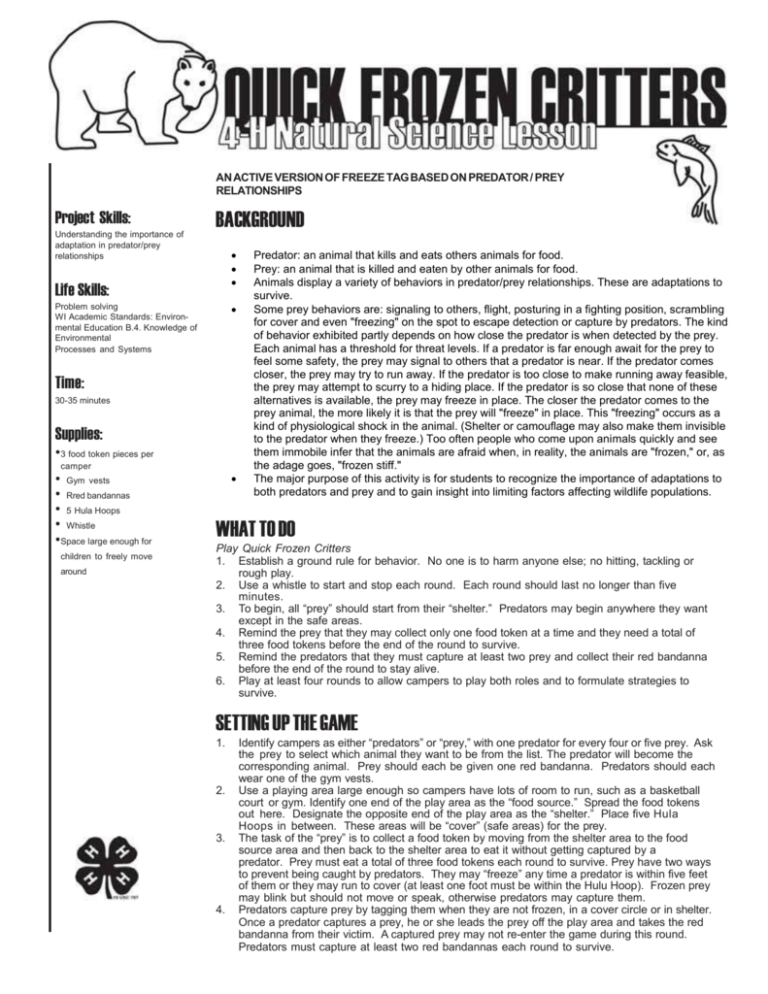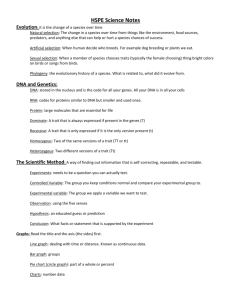Frozen Critters
advertisement

ACTas143 AN ACTIVE VERSION OF FREEZE TAG BASED ON PREDATOR / PREY RELATIONSHIPS Project Skills: BACKGROUND Understanding the importance of adaptation in predator/prey relationships Life Skills: Problem solving WI Academic Standards: Environmental Education B.4. Knowledge of Environmental Processes and Systems Time: 30-35 minutes Supplies: •3 food token pieces per camper • Gym vests • Rred bandannas • 5 Hula Hoops • Whistle •Space large enough for children to freely move around Predator: an animal that kills and eats others animals for food. Prey: an animal that is killed and eaten by other animals for food. Animals display a variety of behaviors in predator/prey relationships. These are adaptations to survive. Some prey behaviors are: signaling to others, flight, posturing in a fighting position, scrambling for cover and even "freezing" on the spot to escape detection or capture by predators. The kind of behavior exhibited partly depends on how close the predator is when detected by the prey. Each animal has a threshold for threat levels. If a predator is far enough await for the prey to feel some safety, the prey may signal to others that a predator is near. If the predator comes closer, the prey may try to run away. If the predator is too close to make running away feasible, the prey may attempt to scurry to a hiding place. If the predator is so close that none of these alternatives is available, the prey may freeze in place. The closer the predator comes to the prey animal, the more likely it is that the prey will "freeze" in place. This "freezing" occurs as a kind of physiological shock in the animal. (Shelter or camouflage may also make them invisible to the predator when they freeze.) Too often people who come upon animals quickly and see them immobile infer that the animals are afraid when, in reality, the animals are "frozen," or, as the adage goes, "frozen stiff." The major purpose of this activity is for students to recognize the importance of adaptations to both predators and prey and to gain insight into limiting factors affecting wildlife populations. WHAT TO DO Play Quick Frozen Critters 1. Establish a ground rule for behavior. No one is to harm anyone else; no hitting, tackling or rough play. 2. Use a whistle to start and stop each round. Each round should last no longer than five minutes. 3. To begin, all “prey” should start from their “shelter.” Predators may begin anywhere they want except in the safe areas. 4. Remind the prey that they may collect only one food token at a time and they need a total of three food tokens before the end of the round to survive. 5. Remind the predators that they must capture at least two prey and collect their red bandanna before the end of the round to stay alive. 6. Play at least four rounds to allow campers to play both roles and to formulate strategies to survive. SETTING UP THE GAME 1. 2. 3. 4. Identify campers as either “predators” or “prey,” with one predator for every four or five prey. Ask the prey to select which animal they want to be from the list. The predator will become the corresponding animal. Prey should each be given one red bandanna. Predators should each wear one of the gym vests. Use a playing area large enough so campers have lots of room to run, such as a basketball court or gym. Identify one end of the play area as the “food source.” Spread the food tokens out here. Designate the opposite end of the play area as the “shelter.” Place five Hula Hoops in between. These areas will be “cover” (safe areas) for the prey. The task of the “prey” is to collect a food token by moving from the shelter area to the food source area and then back to the shelter area to eat it without getting captured by a predator. Prey must eat a total of three food tokens each round to survive. Prey have two ways to prevent being caught by predators. They may “freeze” any time a predator is within five feet of them or they may run to cover (at least one foot must be within the Hulu Hoop). Frozen prey may blink but should not move or speak, otherwise predators may capture them. Predators capture prey by tagging them when they are not frozen, in a cover circle or in shelter. Once a predator captures a prey, he or she leads the prey off the play area and takes the red bandanna from their victim. A captured prey may not re-enter the game during this round. Predators must capture at least two red bandannas each round to survive. ENHANCE • • • As soon as prey is captured, he or she becomes a predator. This will increase the ratio of predators to prey. Conduct this variation for at least three or four rounds. You will need additional gym vests. Make sure to discuss how this variation affected the game. Have the campers change the way they can move. Play a round where campers can only hop, another where they can only walk, etc. If some prey keep winning, play a round where some of the prey have been injured and have to hop on one leg, or have young to take care of and have to collect twice as much food. TALK IT OVER Try to get each camper to express his or her feelings and experiences. Reflect: • How did prey escape capture? Which methods were most effective? • What did predators do in response to a prey who “froze”? • After playing the game for a while, how did you change your strategies to better survive? Adapted from Project Wild, pages 122-124. Apply: • How is this game similar to real predator/prey survival? • How does changing the number of predators in the real world change the survival situation for prey? How does it change the survival situation for predators? • How does changing the number of prey in the real world change the survival situation for predators? How does it change the survival situation for prey?







